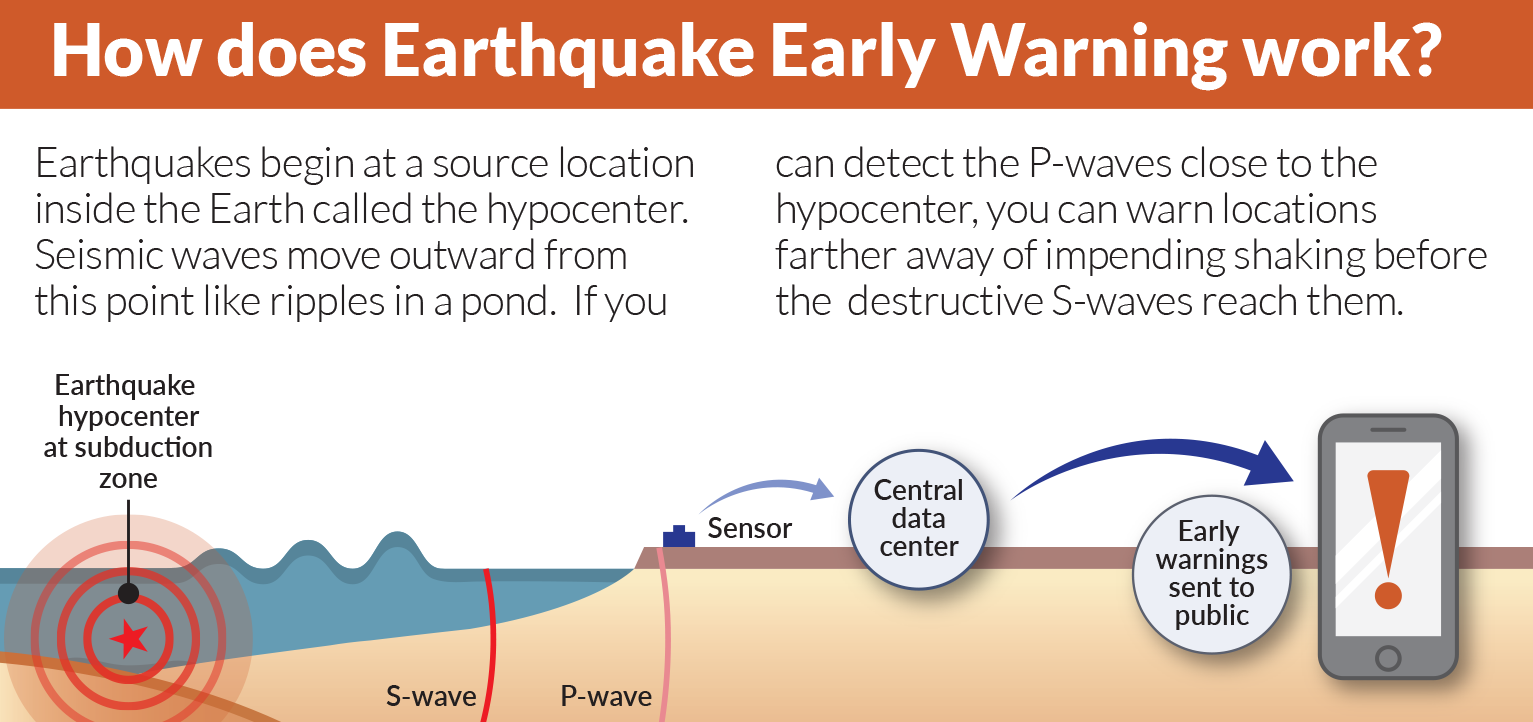

Earthquakes happen in Alaska. A lot. How would an earthquake early warning system work here?
Imagine you are driving, and you get a warning on your cell phone that intense shaking will start in 5 seconds. You have just enough time to pull to the side of the road. Or maybe a surgeon is in the midst of a procedure, and because of an alert that strong shaking is about to start, has enough time to set down sharp tools.
An earthquake early warning system does not predict when or where an earthquake will happen in the future. Rather, it’s a lightning-quick response to a large earthquake that has already started. Japan, Taiwan, Mexico, China, Italy, Romania, Turkey, South Korea, Israel, and Canada have developed earthquake early warning systems. Between 2018 and 2021, the earthquake-prone western states of California, Oregon, and Washington also publicly launched earthquake early warning systems.
Japan has one of the most advanced systems, pioneered so that high-speed trains can slow down and stop before shaking reaches the train’s location. The system began issuing warnings in 2007. In 2011, when the magnitude 9.0 Tohoku earthquake struck, the early warning system provided residents of Tokyo 80 seconds of warning before shaking started.
An earthquake early warning system is essentially a race between seismic waves and communications signals. Seismic waves travel through the earth at a few miles per second. Cell phones and radios transmit signals using waves that are part of the electromagnetic spectrum, which travel at the speed of light, 186,000 miles per second.
The race starts when an earthquake occurs. Seismic waves from the earthquake reach a seismometer. The seismometer sends data to a central processing facility. When a minimum of four seismic sensors detect the earthquake and transmit their data, a computer program calculates the location and magnitude of the earthquake rupture and estimates the shaking. If the shaking is strong enough to trigger an alert, the system automatically sends a message to cell phones and emergency broadcast systems—at the speed of light.
On average, there is an earthquake about every 10 minutes somewhere in Alaska, but most are small or deep enough that people don’t feel any shaking. Certain areas of the state are more seismically active than others. While we want the system to give accurate alerts for potentially damaging earthquakes, we don’t want to send out alerts too frequently for smaller earthquakes that wind up not causing damage. We want people to take the alerts seriously when they occur.
Returning to the race analogy, winning would mean the alert beats the earthquake with enough time for people to take safety actions. Sometimes the alert will arrive well before shaking, sometimes only seconds before. For shallow crustal earthquakes, people close to the earthquake origin may feel the shaking before enough seismic stations have recorded and sent data to trigger an alert. The goal is to configure the sensor network and data analysis to maximize advance notice.
A dense seismic network is one necessary component. The Alaska Seismic Hazards Safety Commission states that Japan has over 4,300 seismic stations, about one per 34 square miles. But Japan is a small country, with large, highly urban areas. Alaska currently has 500 stations across a much larger area, but we have fewer urban areas. “In Alaska, the model we are considering is different station spacing in different places. If the optimal spacing is 20 km between stations, then that is what we will try to achieve in certain areas, with a larger spacing in other areas,” said Mike West, the state seismologist at the Earthquake Center. “We are still looking at what those areas are.”
Assessing the capabilities of the current seismic network is a second component. “The big hurdle for us is telecommunications in Alaska. The challenge is getting data back to the center really, really fast,” said West.
The Alaska seismic networks would need substantial upgrades to be ready to handle an earthquake early warning system. “The networks currently are not dense enough and have too long of latencies,” said Natalia Ruppert, senior scientist at the Earthquake Center, referring to the time between when an earthquake happens and when data reaches the Earthquake Center. “You have to have data within a few seconds, and right now, maybe 10% of our stations are under 5 seconds latency.”
As with many things, what works in the Lower 48 doesn’t quite fit Alaska. The current computer programs for processing seismic data for earthquake early warning alerts in California, Oregon, and Washington have been primarily tested for crustal earthquakes. Alaska, however, also experiences deeper, subduction-zone earthquakes. So we will need to develop systems that will work accurately for Alaska’s seismic situation.
Another aspect of the assessment is determining an initial coverage area. “Having all of Alaska covered right away is unrealistic,” said Ruppert. “We need to identify an area of notification, which will dictate how many stations we’ll need to have to provide timely warnings.” Running a test phase in a portion of Alaska would help fine tune an early warning system before expanding to cover the entire state.
All of these moving parts mean this will be a long process. Ruppert said, “It will take time and financial investment from the state and from the federal government to bring up the seismic infrastructure in Alaska to be able to provide earthquake early warning.”
Stay tuned for more stories as we explore how the earthquake early warning program unfolds in Alaska.
Listen to this “Get Ready Alaska” podcast interviewing the Earthquake Center’s Natalia Ruppert about earthquake early warning.
Alaska Seismic Hazards Safety Commission and Alaska Division of Geological and Geophysical Surveys earthquake early warning fact sheet

